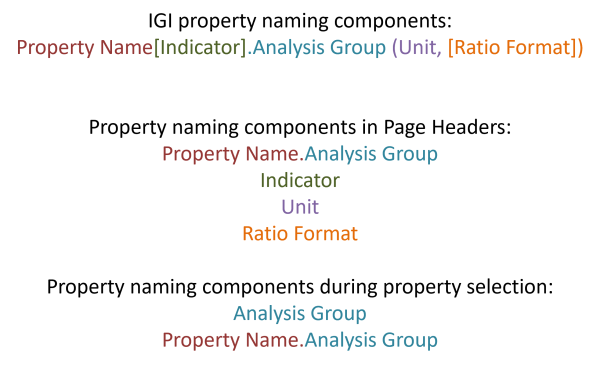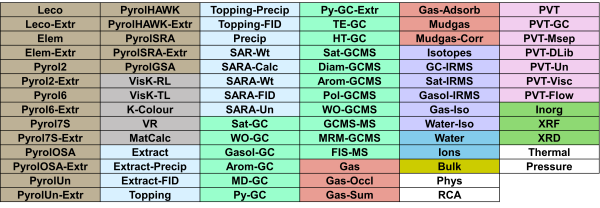Naming in the IGI property model
Overview
IGI's geochemical software (Metis and p:IGI+) contains a comprehensive industry-relevant property model. This page explains the naming schema used in the IGI property model.
Usage: Throughout the system, particularly during import and interaction with the range of visualisation artefacts.
How to use in practice
At its core, the IGI property model has been designed around the commonly utilised analytical techniques available in geochemical labs. Consequently, IGI has employed a property naming convention which provides clear differentiation between the analysis employed, the property name and the contextual measurement information (Indicator, Unit, Ratio Format) .

The p:IGI+ property model naming convention and display format as presented across the software.
Property Component Elements
A complete property description comprises several elements:
- Property - A particular aspect of a sample (often a physical or chemical characteristic) on which a measurement is made, e.g. TOC, nC10 concentration, vitrinite reflectance (%Ro). The property name is specified using a short naming convention in most areas of the software.
- Full Property Name - A longer description of the property, including key molecular arrangements, available for reference in the geochemical help and on hover while using property search.
- Analysis Group - The associated procedure / analytical technique by which a sample's specific properties are measured, e.g. LECO, WO-GCMS, GC-IRMS etc.
- Indicator - Molecular and gas data compounds can be measured in different ways:
-
-
- Molecular data: can be reported as peak heights [h], peak areas [a], concentrations derived from heights [ch] or areas [ca], or without information, and so is an unknown [un] measurement.
- Gas data: can be given as mass [mass], volume [vol] or mole [mol] fractions, or without information, and so is an unknown [un] measurement.
-
Note: The IGI property model has the capacity to store data for multiple indicators simultaneously, as labs often provide data as both raw count and concentration values. There is no clear agreement on which form of measurement should be preferred, so we offer the ability to store all the data, enabling the user to use.
- Unit - a standard reference system used to quantify/provide meaning to a measurement, e.g. %wt, degrees centigrade, micrograms per gram.The unit Euc stands for Euclid, a natural non-dimensional unit.
- Ratio - used to define properties as the quotient of two other properties, e.g. Pr/Ph - Pristane/Phytane and to specify if the ratio is in its un-normalised (a/b) or normalised (a/(a+b)) form. The ratio is independent of the unit.
Currently, there are over 80 analysis groups within the IGI property model. This is continually under review, and new analysis groups and properties are added as a result of user requests and review.
The analysis groups present as of version 3.0 are shown below:

Video tutorials
None Available
Return to the Property Model User Guide page
© 2025 Integrated Geochemical Interpretation Ltd. All rights reserved.
